Natural horsemanship has been gaining popularity and becoming more “main stream”. You may find yourself asking “What is Natural Horsemanship?” and “Why is it becoming so popular?”
In this article I will explain the fundamentals of natural horsemanship as well as introduce basic ideas to gain better control and obedience from your horse.
There are a lot of natural horsemanship “brands” out there, but the basic core concepts remain the same regardless of the trainer or the country. In its most basic form, natural horsemanship incorporates herd behaviour and psychology to alter or enhance a horses relationship with their owner.
Most people come to natural horsemanship when traditional methods are no longer working for them. It helps them become more confident, and in turn helps their horse become more confident.
As confidence builds, the horse becomes more trusting and respectful. Trust and respect create obedience, and this leads to calmness.
Some trainers like to keep a mystique to their techniques, but its not magic. Anyone can do it. Here are some basic concepts to remember when starting with natural horsemanship.
A horse is a herd animal. In a herd situation, there is a hierarchy. There is always 1 leader. In the wild this would always be an older mare. If you watch a group of horses, you will notice 1 horse that does what ever they want, and the rest move around them.
In natural horsemanship you are doing exercises to show your horse that you are a natural leader. Most horses are seeking this leader, and are unconvinced a human can play that role. This creates problems such as barn sour horses, nervous horses, lack of attention or respect and bossiness.
In order to convince your horse you are a natural leader, you emulate behaviour they recognise. The leader does not move unnecessarily, the subordinates move around them. The leader maintains personal space, and does not allow other horses to be pushy or disrespectful to that space.
When the leader moves, the others step aside, and respectfully let them by. They follow their leader and pay attention to their commands.
Here are a few things to keep in mind when starting down a more natural training program.
Be aware of any time you feel your personal space has been invaded in a pushy or disrespectful manner, and ask your horse to step over a bit. This is particularly important in the stable or when leading.
Notice how often you move yourself around your horse, and try to move your horse around you instead. Remember the leader moves their feet less then the subordinate.
Try to be definite in your movements, on the ground and in the saddle. Leaders always have a plan, and don’t meander. Try to always be going somewhere with purpose.
Horses love their leaders. Remember to keep the friendship strong. A good grooming, especially in the wither area can show your horse how much you care. See if you can find your horses favourite itchy spot and give it a good scratch, particularly when your horse is behaving as desired. Perhaps a lovely bit of grass after a good ride, to show him you can do things he likes as well.
In some of my other articles I show ways to start your journey of becoming a good leader and great friend for your horse. You will naturally gain a calm, obedient, and respectful partner.




Leave a Reply
You must be logged in to post a comment.